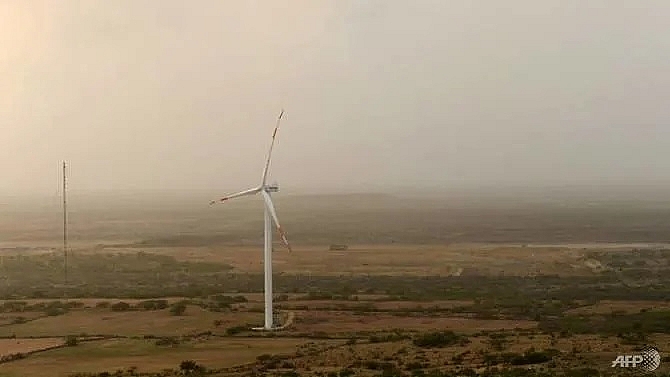India to build solar, wind farms along Pakistan border
 |
| India is raising its investment in renewable energy at a breakneck pace AFP/SAM PANTHAKY 21 Oct 2019 09:57PM (Updated: 21 Oct 2019 09:57PM) |
Mired in an economic slowdown, the government has tripled spending over the last three years as part of its push to cut down the use of oil and coal.
"We are studying land feasibility and have identified projects worth 30 gigawatt capacity for Gujarat and 25 gigawatt capacity for Rajasthan," Anand Kumar, new and renewable energy secretary, told AFP.
The government had zeroed in on barren desert areas in a bid to avoid using agricultural land, he said, adding the sunny and windy region was ideally suited to renewable energy facilities.
Work on the projects would begin roughly 18 months after approval from the defence ministry and following land feasibility studies, he said.
"These projects will help reduce India's carbon footprint and adhere to promises made at the 2015 Paris agreement," Kumar said.
India currently harnesses 23 percent of its total power from renewable sources, including solar and wind.
R.K. Singh, minister for power and renewable energy, told parliament in July that India's capacity had crossed 80 gigawatts and was on track to reach 175 gigawatts in three years' time, as pledged by Prime Minister Narendra Modi.
However, private investment in the renewable sector remains low, and the government has found securing land for projects difficult.
Renewable energy projects are not feasible in agricultural or forest lands, said Amit Bhandari of Mumbai-based think tank Gateway House.
"Since most of these western border areas are wastelands or semi-desert, they are perfect for setting up these projects," he told AFP.
Meanwhile, investment in fossil fuel-based energy sources continues to rise in the South Asian nation, with both French energy giant Total and Saudi Arabia's Aramco buying stakes in Indian companies.
What the stars mean:
★ Poor ★ ★ Promising ★★★ Good ★★★★ Very good ★★★★★ Exceptional
 Tag:
Tag:
Related Contents
Latest News
More News
- Heavy industries set for pilot greenhouse gas quotas (December 25, 2025 | 10:00)
- Swedfund invests in MSME growth and climate action in Vietnam (December 19, 2025 | 11:42)
- GreenYellow brings solar energy to light up remote schools in Tuyen Quang province (December 19, 2025 | 08:00)
- Charge+, Grab partner to develop EV charging network in Vietnam (December 18, 2025 | 17:11)
- Linking sci-tech and innovation to Vietnam’s net-zero future (December 18, 2025 | 14:31)
- Driving double-digit growth through green and circular transformation in Vietnam (December 17, 2025 | 09:00)
- Standard Chartered and ACCA deepen collaboration to develop Vietnam’s talent for a sustainable future (December 15, 2025 | 18:18)
- Schaeffler reports strong early output from Dong Nai solar project (December 12, 2025 | 15:16)
- Forestry conference highlights biodiversity and sustainability goals (December 09, 2025 | 13:35)
- Home Credit honoured among top 10 sustainable companies in trade and services (December 09, 2025 | 12:18)























 Mobile Version
Mobile Version